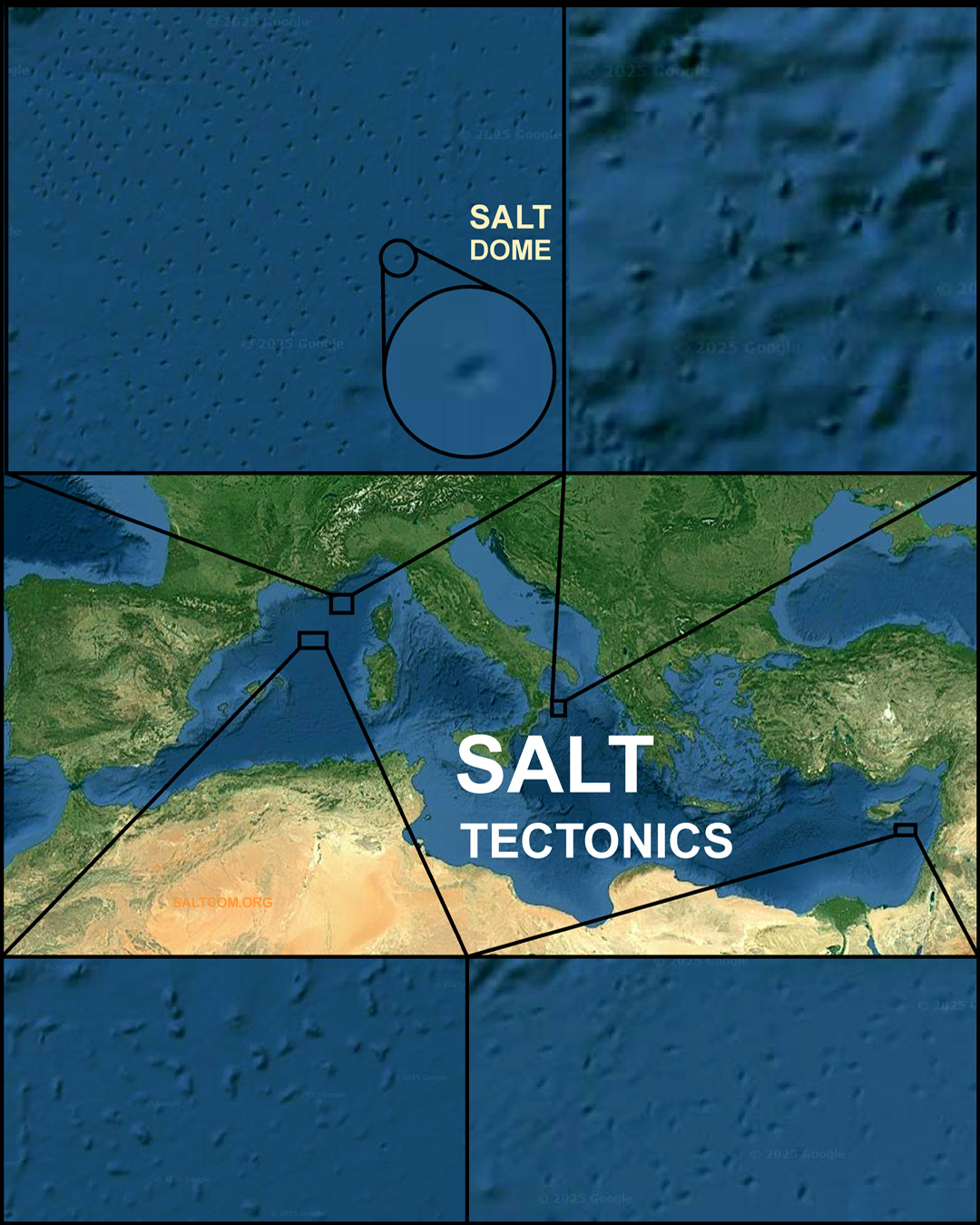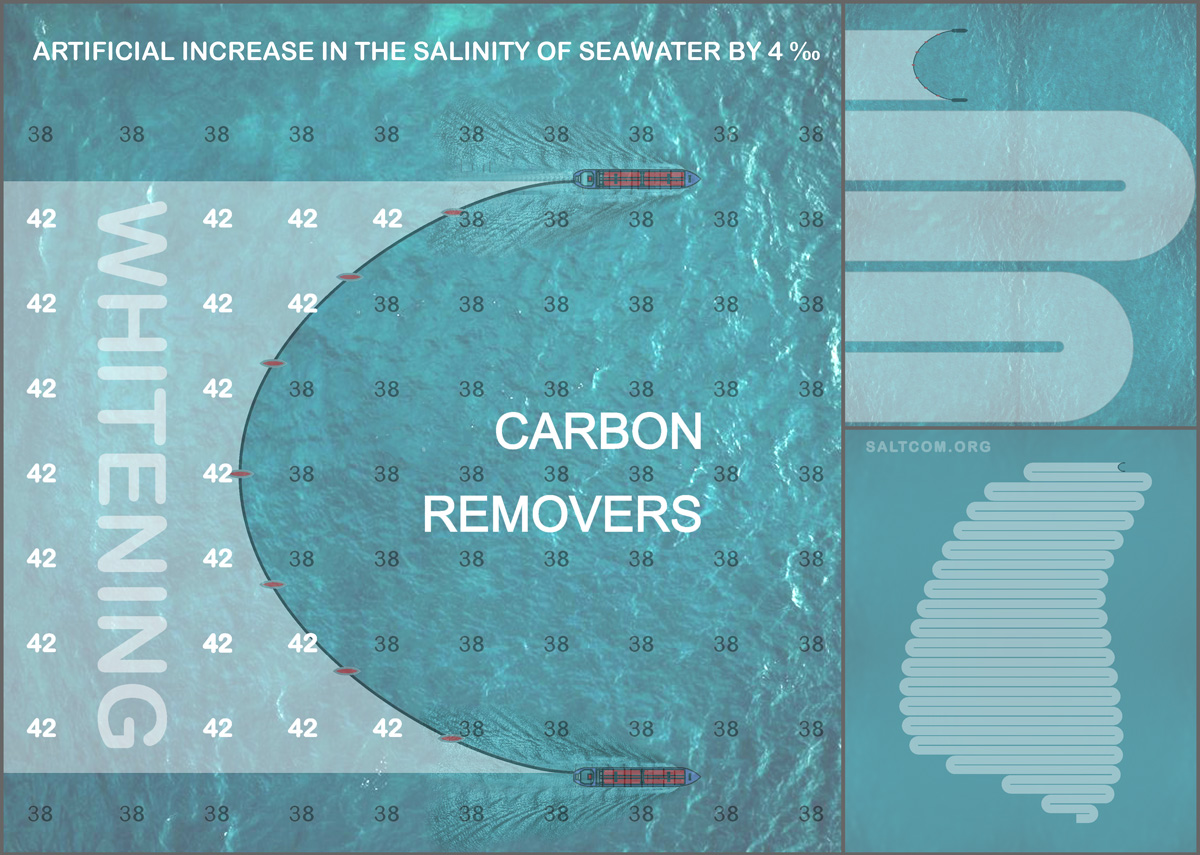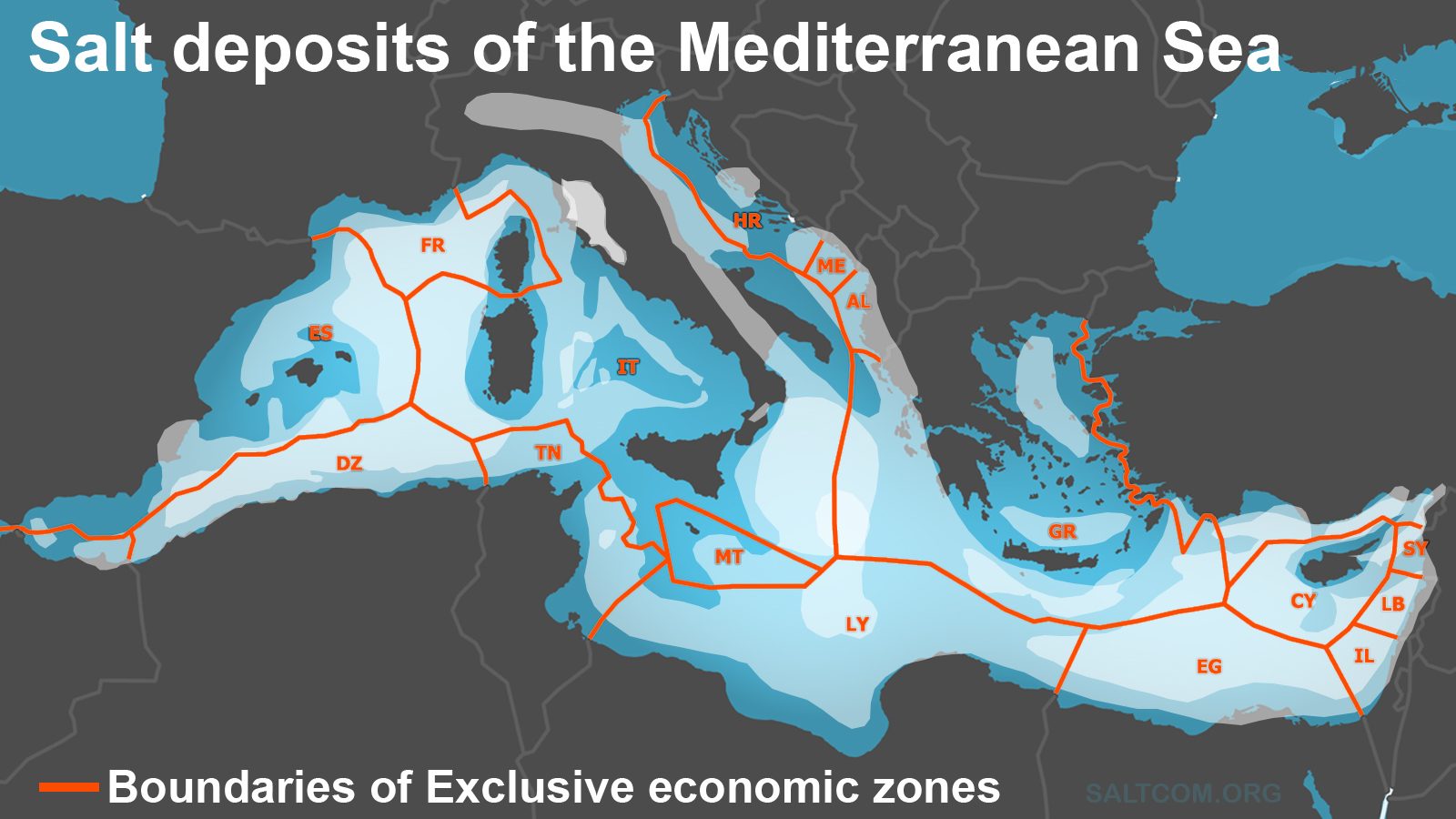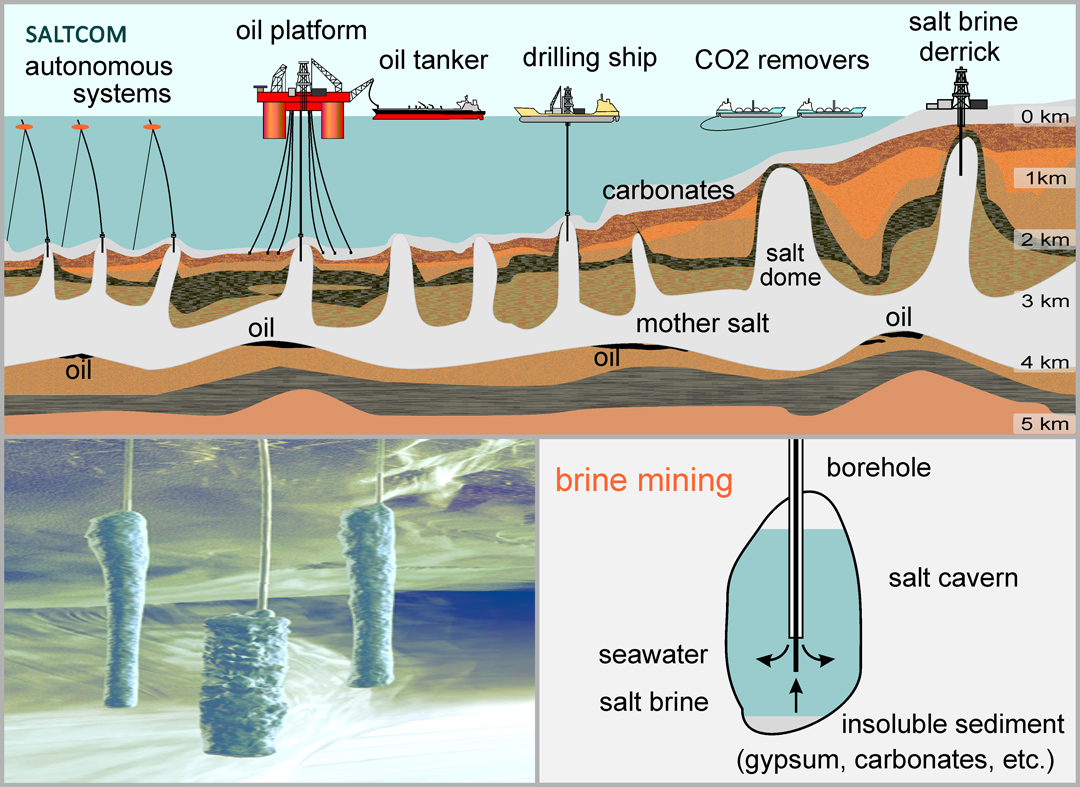![]()
Andrey Solver, April 14, 2025.
![]()
Andrey Solver, April 14, 2025.

The Mediterranean Sea has repeatedly dried up and filled with water. Its salinity varied critically over a wide range from semi-fresh lagoons of estuaries to hypersaline lakes in deep-water areas. The most famous episode in geological history is the Messinian salinity crisis. An event that occurred 5.97 – 5.33 million years ago, as a result of the overlap of the connection with the Atlantic. The sea dried up almost completely in a short period of 2 – 20 thousand years.
Currently, the Mediterranean Sea contains 3.7 mln km3 of water. During the year, rivers bring 200 km3 of water into it, 1200 km3 of precipitation falls, and 4700 km3 evaporates. The final water deficit of 3300 km3 per year is replenished with water from the Atlantic through Gibraltar (please see our a breakthrough technology of generating electricity from this stream).
The salinity of the Mediterranean Sea is much higher than the global average 35 grams per liter and is about 38 – 39 ‰. This is very significant for our discourse on carbon removal, but even if all the seawater evaporated, there would be a layer of salt only 30 meters thick. Whereas in reality there is much more solid salt under the seabed. In almost a large area of the Mediterranean Sea, there are layers tens and hundreds of meters thick, and in the abyssal regions, salt layers reach a thickness of 2 – 2.5 km.
The total mass of dry salt is about 4 million gigatons (4×1015 tons) and a volume of 2 mln km3. That is, salt is more than half of all seawater! Many residents of the Mediterranean coast will probably be surprised to learn that there is more undissolved salt in the sea than dissolved salt in seawater by more than 28 times!
Wikipedia incorrectly calls this salt Messinian, but it is not. Most of it is more ancient and belongs to the Triassic period (251-201 million years ago) and partly to the Jurassic (201-145 million years ago). So, it is related to the Arabian salt and the Mexican salt basin. It was deposited at a time when the Atlantic Ocean did not yet exist.
The salt tectonics of the Mediterranean basin is the same as in the Gulf of Mexico/America, with diapirs and salt domes everywhere. Interestingly, they were discovered by the famous Jacques-Yves Cousteau. At a depth of 2.5 km, his deep-sea apparatus explored convex bottom uplands, hills rising 100-300 meters above the flat bottom. Subsequent drilling confirmed his guesses: the hills are the tops of salt domes about 2 km high. In scientific articles on salt tectonics at the bottom of the sea, there is a comparison with "cobblestone pavement".

These upland patterns at the bottom are formed by Triassic salt, which breaks through to the surface, forming complex 3D formations with other younger salt layers. The Mediterranean salt basin is called supergiant, it contains about 5% of the salt of the World Ocean.
I could tell you a lot of interesting things about these salts, the origin of which has many mysteries and paradoxes. For example, about the layers of coal between the layers of salt, which were formed in completely different conditions than salt, and are found in many places in the Mediterranean, as well as on the surrounding land.
But this article is about economics. Salt is a huge wealth that has not yet been used. This is the reverse side of climate change, which makes it possible to compensate for anthropogenic CO2 emissions. Please read about our salt CO2 removal technology by depositing it in a mineral calcite, CaCO3, calcium carbonate on the seabed. This globally scalable technology is the only one in the world that is thermodynamically profitable, that is, the result of CO2 removal exceeds the energy spent on it. We claim that it can stop Global warming.

The essence of this technology lies in the dialectical unity of opposites: a change in the salinity of seawater beyond the thermodynamic threshold for almost immediate precipitation of solid sediment, the so-called “whitening”, as well as a long tail of biological deposition of carbonates, continued for a long time. Processes calculated by mathematical models, which are reduced to the exact ratio of CO2 / salt. The threshold for “whitening” is 28°C and 41 ‰.

On the temperature map, you can see where this technology can be implemented and where it achieves maximum efficiency. It should be noted that this is a one-time pattern, the temperature is changing. Unlike the constancy of salt deposits.

It should be noted that the geology of the bottom of the Mediterranean Sea is not well studied in comparison with the neighboring Gulfs: the Persian and Mexican/American ones, which in ancient times formed a single salt belt.
While the oil and gas-bearing areas in the eastern part of the sea have been more or less explored and their practical operation has begun, many discoveries remain to be made in the central and western parts. There is no doubt that large deposits of oil and gas will be discovered everywhere. Why? Because the conditions for the formation of local salts are the same as those outside the ocean.
Salt and oil are almost always found together. The fundamental difference between salt and other rocks lies in its ionic crystal lattice, in which the atoms are interconnected by electrostatic attraction. At great depths and at high pressure, salt becomes fluid, penetrates through the overlying rocks and forms a movement within geological deposits – salt tectonics. Salt formations and bodies are completely impervious to organic substances, which are lighter than the surrounding rock and which seep to the surface under high pressure. Salt forms traps for these organic fluids. This is how oil and gas fields are formed.
If oil is not being mined where there is salt, then it means that it was poorly searched for.
Another companion of salt is carbonates. Limestones, dolomites, chalk, marble – everything that consists of CaCO3 and MgCO3. The bottom of the salty Mediterranean Sea consists of more than 80% carbonate sediments. Any diver can confirm that the bottom of this sea is white. Despite this obvious fact, the reasons for this connection between salts and carbonates are deeply understood by only a few people around the world. Please read our research in the field of chemical thermodynamics and kinetics.

Most of the houses on the coast are built of limestone. The Colosseum, the Pantheon, the Tower of Pisa, the Parthenon, St. Sophia Cathedral, the Sphinx and the Pyramids are all limestone, remnants of marine organisms. Cement is a mixture of silicon and carbon.
Needless to say, the surface of the land, the rocks are deposited CO2. The French Mont Blanc Mountain and the Italian dolomite Alps are layers of hundreds and thousands of meters of carbonates – carbonate ions in seawater turned into stone. This conversion of carbon dioxide from the atmosphere , CO2 into a solid mineral, CaCO3, is impossible without salt. And there is a direct dependence of this process on its percentage in water or salinity.
We can formulate a rule: the higher the salinity (up to a certain limit of about 44 ‰), the more intensive the precipitation of carbonates is. In fresh and semi-saline water, the formation of carbonates is very small, and in water without salt (rain, distilled) their formation is thermodynamically prohibited. Rivers wash away carbonate minerals, dissolve limestone, release accumulated CO2 into the atmosphere, and carry calcium ions into the sea. In contrast, salty seas are home to corals, shells and other calcite-fixing organisms, mainly single-celled foraminifera and coccolithophores, the main CO2 removers on Earth.
This leads to a simple conclusion: if the salinity of the Mediterranean Sea is such a high 39 ‰, then it is possible to artificially increase it by a very small value of 2 ‰ (2 parts per 1000) and directly chemically precipitate carbonate ions into carbonate minerals.
Question: Is it dangerous for marine life?
Answer: Look at the abundance of life in the very salty Red Sea (41 ‰), where "whitening" occurs regularly and spontaneously during the hot seasons. Most organisms are tolerant to such a small change in salinity. We can say that all organisms are stable, and calcite-fixing biota grows better. The productivity of the foraminifera increases in proportion to salinity, and with it all life along the food chain from plankton to fish and fishermen.
![]()
The solubility of CO2 in water depends on salinity (according to Henry's law), but with such a small change in the amount of salt, this difference is negligible. Whereas this small fraction of salt can significantly affect the deposition of aqueous CO2, carbonate and bicarbonate ions. Under certain conditions, it is possible to purify water from dissolved carbon almost completely.
A carbon pump is created that pumps CO2 out of the atmosphere and removes it to the bottom in the form of carbonate minerals. Kilometer-long limestone strata are the process of absorbing carbon dioxide from the atmosphere over millions of years.
![]()
The practical application of this carbon pump is possible if we loop history. Extract salt from the bottom of the sea and place it on the surface (in the water column). For this, there are long-developed brin-mining technologies, which extract a large share of salt on the planet. Water is pumped into the drilled well and brine is pumped out. Although deepwater drilling has developed relatively recently, the entire line of drilling equipment already exists.

In modern offshore oil production, the main vertical well at a depth of several kilometers is divided into many horizontal branches that radiate in all directions. They form a kind of umbrella or tree and penetrate into numerous oil cavities that form under salt formations or brines. Their combined length can reach tens of kilometers.
Such a complex 3D structure is not needed for brin mining. One vertical well drilled to a shallow depth of 300 – 500 meters is sufficient. Usually, the cap of insoluble rocks above the salt dome is small, 50 – 100 m. The equipment for the brine extraction process is minimal and maintenance-free – it's just a small pumping station at the bottom. The large difference in the scale of salt and oil by thousands of times makes regular drilling unnecessary, associated with the depletion of oil-bearing layers. It is not possible to deplete a salt dome with a volume of several tens of cubic kilometers in the foreseeable time.
In principle, it is possible to do without CO2 removers, ships that distribute brine over the surface, which are described in our previous works. We can use sea currents. In this case, the set of equipment is limited to a pumping station at the bottom, a hose, a float and a holding rope.
And if we add to this minimum our minimalistic technology of MHD generation of electricity from seawater, based on new physical principles, without any moving parts, we get a super-hyper technology that:
• removes CO2 continuously, sink carbon to the bottom for millions of years (in the Mediterranean Sea, there are few depths below the lysocline of 3-4 km at which CaCO3 is dissolved);
• increases overall biological productivity;
• does not require human intervention;
• does not require energy consumption;
• and even additionally generates tens of kilowatts of renewable electricity.
Any questions by email: